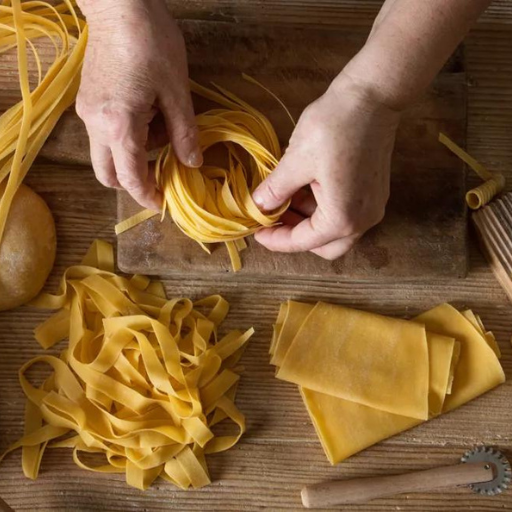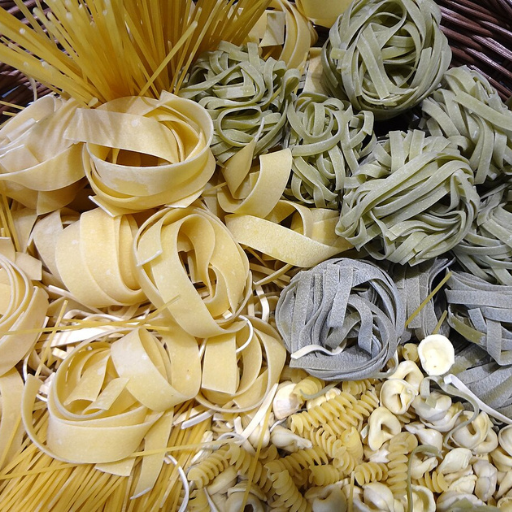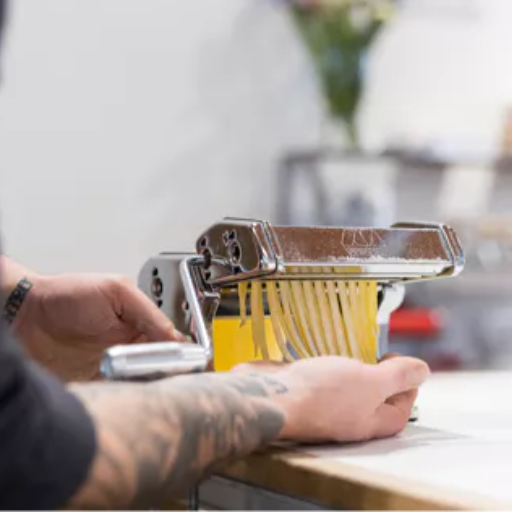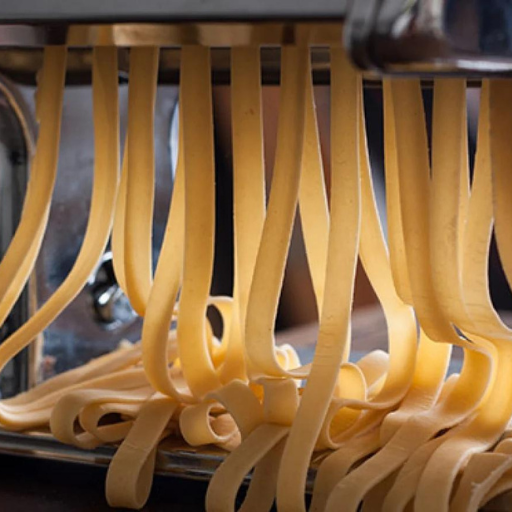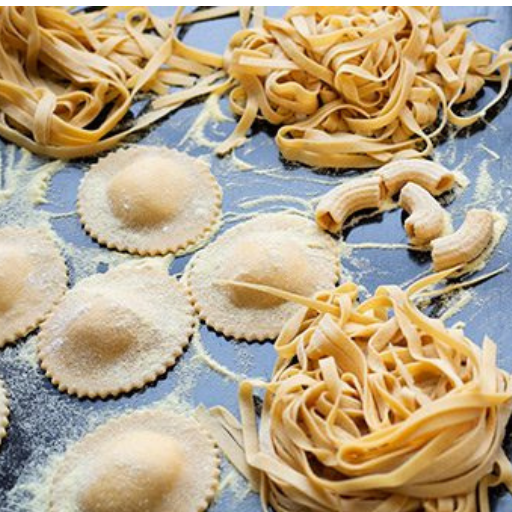Are you tired of store-bought pasta that lacks the freshness and flavour of homemade? Look no further! Our article introduces you to the ultimate pasta macaroni making machine, a game-changer for every kitchen enthusiast. Whether you’re a seasoned chef or a culinary novice, this machine simplifies the process of making delicious pasta right at home. In the following sections, we will delve into the features and benefits of this remarkable device, guide you through its user-friendly operation, and share some mouth-watering recipes to get you started. Get ready to elevate your pasta-making experience to a whole new level!
Choosing the Best Pasta Making Machine for Your Home
What is Better for You: an Electric Pasta Maker or a Manual Pasta Machine?
In deciding between manual and electric pasta makers, it boils down to personal choice, budgetary constraints, and how frequently one plans to make pasta. Each type has its own pluses and minuses which are crucial for you to know before making a decision.
Practicality:
- Manual Pasta Machines: For these ones, you will probably require some muscle since the dough is rolled out by turning a hand crank. They offer more control over thickness though can be tiresome when large quantities are involved.
- Electric Pasta Machines: These are very user friendly because quite a bit of the work is done for you including mixing as well as extruding the dough. Ideal if you would like something that is easy to use and does not require much of your energy when preparing larger meals.
Speed:
- Manual Pasta Machines: Usually slower as there are several settings through which dough must pass manually.
- Electric Pasta Machines: Quicker and more efficient, able to turn out pasta in less time than before.
Price:
- Manual Pasta Machines: Usually less expensive; they are good options for those on tight budgets or who do not make pasta often enough.
- Electric Pasta Machines: On the other hand, these have higher costs because of advanced features and convenience that they provide hence referred as long-term investments among ardent enthusiasts of homemade pasta.
Variety:
- Manual Pasta Makers: These machines can be versatile in terms of different shapes of pasta or different thicknesses with various attachments that come with them;
- Electric Pasta Makers: Majority models have many settings together with attachments so as to prepare any kind of pasta such as spaghetti, fettuccine even lasagna noodles without any difficulties.
Storage Space:
- Manual Pasta Makers: Smaller sizes generally allow them to be stored in your kitchen without consuming too much space
- Electric Pasta Makers: More commonly though bulkier requiring more counter top space. You should check the space available in your kitchen to see if it is enough for the machine’s presence.
Ease of cleaning:
- Manual Pasta Makers: These are easier to clean because they have simple designs and can be wiped after use.
- Electric Pasta Makers: Though mostly time-consuming as a result of more components and parts to clean, modern devices are often designed to facilitate taking apart and cleaning them as well.
Both the manual pasta maker and the electric pasta machine have their own pros. In case you value tradition, control, and economy; then, a manual pasta maker will serve you right. Conversely, an electric pasta maker will be beneficial if your focus is on convenience, speed, or you intend to purchase a slightly more advanced device.
Necessary Features for Choosing a Pasta Maker
When buying pasta makers it is essential that certain factors have been considered so that you can make a proper selection based on your needs. Here are some of the crucial features that should not be left out:
Material quality:
- Durability: Pasta makers made with high-quality and durable materials such as stainless steel are ideal since they last long without rusting.
- Machine construction: A good built machinery also means better performance over time. Avoid something flimsy or lightweight as they may not tolerate rigorous use very well.
Simple design:
- User-friendly design capabilities: It would be great if there are intuitive control panels or buttons in them. On manual machines they should turn easily while electronic ones need simple settings only.
- Clear Instructions: Make sure the pasta maker comes with an elaborate user guide. Video tutorials can be an added advantage also.
Versatility:
- Attachments and Settings: A perfect pasta maker should avail diverse attachments for making various shapes and thickness of pastas. Confirm whether the machine is able to process all types of pastas such as spaghetti or lasagna sheets.
- Customization: It is important to be able to set the dough thickness and pasta shape in order to achieve full satisfaction.
Ease of Cleaning:
- Disassembly: Go for a pasta maker that you can easily dismantle when cleaning it. This will help ensure hygiene and long life of the machine.
- Cleaning Tools: Some models have special brushes or tools for cleaning hard-to-reach parts of the equipment. This saves time considerably.
Size and Storage:
- Space Requirements: How many countertop space do you have? Manual pasta machines are usually smaller, while electric ones may require more room.
- Storage Solutions: In case you lack space, go for foldable designs or those with compact storage options that will fit in kitchen cabinets comfortably.
Speed and Efficiency:
- Manual vs. Electric: Electric pasta makers are usually quicker thus allowing you to make large amounts in a short time span. Manual ones might take longer but give better control options.
- Performance Check reviews or if possible, test out a machine so that it performs efficiently giving consistent results.
Price and Value:
- Budget Choose your budget then compare features at different price points.Hence, bear in mind that higher prices often lead to better quality together with extra features hence rate them as an investment done by buyers
- Warranty and Support Look out for warranties on these machines as well as good customer care services which could be very helpful just incase something happens or needs some replacement
By remembering these features you will be able to decide correctly on what type of a Pasta Maker suits your culinary skills and kitchen requirements best.
Exploring the Capabilities of Macaroni Making Machines
What distinguishes pasta makers from macaroni machines?
There are several ways in which pasta makers vary from macaroni machines. Now, as an expert in this field, let us make a clearer breakdown of these differences:
Functionality:
- Pasta Makers: These are versatile appliances that can create different pasta shapes and varieties. They can produce spaghetti, fettuccine, lasagna sheets among others. Some advanced models also have attachments for making ravioli and other stuffed pastas.
- Macaroni Machines: They specialize on tubular pasta shapes such as macaroni, penne and ziti. They usually come with specific extruding dies to shape the dough into the desired forms.
Design and Construction:
- Manual Pasta Makers: Normally this involves rolling and cutting mechanisms where dough is flattened then cut into strips or shapes. They are often relatively small in size and require manual efforts.
- Electric Pasta Makers: These are machines which automate kneading, rolling and cutting processes. What type of pasta will be produced depends on the use of attachments.
- Macaroni Machines: These types of devices mainly concentrate on pushing dough through variously shaped dies; they can be more sophisticated with components made to maintain the structure and texture of tubular pastas.
Ease of Use:
- Pasta Makers: Manual models necessitate more hands-on workmanship for consistent results while electric ones simplify this process though some familiarity with the machine may still be required.
- Macaroni Machines: Mostly user-friendly designs that allow for fast production of large quantities of macaroni with little attention by users.
Cleaning and Maintenance:
- Pasta Makers: Cleaning can be simple for manual units but may take longer when it comes to electric ones especially if they have multiple parts that need removal.
- Macaroni Machines: Because these machines use intricate extrusion systems; cleaning might require extra care. Some models however incorporate easy-to-clean designs or even special cleaning tools.
Price Point:
- Pasta Makers: Manual ones are generally cheaper while electric pasta makers can be more expensive due to their advanced features.
- Macaroni Machines: Being a specialized equipment, they might fall into higher price category reflecting their purpose-driven nature and sometimes rugged build.
Once you know these differences, you will be able to identify the machine that suits your needs and cooking ambitions best, thereby making the correct choice for your kitchen.
How to Make Perfect Macaroni with an Automatic Machine
Making perfect macaroni with an automatic machine involves understanding and mastering several key parameters. This is a step by step guide on how to make it perfectly using an automatic machine in simple language:
Choosing the Right Ingredients:
- Flour: Opt for high-quality semolina or durum wheat flour as it gives the best texture and structure.
- Water: Maintain a proper water-to-flour ratio; typically, 1 cup of flour needs about one-third cup of water. However, you may have to adjust this depending on your machine’s specifications.
Setting Up the Machine:
- Assembly: Ensure that you have adequately assembled the machine. Find out from the manual which steps are involved so that all parts fit securely together.
- Attachments: Choose an appropriate macaroni attachment. They differ in shape and size so select according to what you want.
Preparing the Dough:
- Consistency: The dough should crumble lightly but still stick when pressed. If too wet, it becomes sticky; if too dry won’t hold properly together.
- Mixing: Employing the mixer function of any available automated machines will ensure evenness throughout the mixtures uniformly mixed.
Extruding Dough:
- Loading: Introduce dough into hopper gradually but steadily.
- Settings of Speed: Consider adjusting the speed settings with respect to the machine type. Newbies had better start at low speed for more control.
- Cutting: As the dough comes out, use a knife to separate macaroni into lengths that are desired by you.
Drying the Macaroni:
- Immediate Use: If you plan to cook it right away then go ahead and boil it.
- Storage: So as to store it properly, dry up all the macaroni. Place them on a drying rack in a cool dry place for not less than 24 hours.
Cooking Tips:
- Boiling Water: To make sure that water is boiling, use a big pot. Add some salt for taste enhancement.
- Cooking Time: Fresh macaroni takes shorter time like 2-4 minutes only. To avoid overcooking check frequently for an al dente texture.
Meticulous following of these steps assures perfect macaroni every time you try making them. Also keep in mind that quality of ingredients and accuracy of following process parameters may have significant impact on result making your homemade macaroni tasty and fulfilling.
Advantages of Making Macaronis at Home Using Macaroni Making Machines
There are several notable benefits associated with using a home-based macaronis making machine. First, pasta made this way is fresh and without any preservatives or artificial ingredients found in mass-produced alternatives. The freshness results in excellent tastes as well as texture thus improving your eating experience. Secondarily, the machine grants full power over contents such that dietary needs such as gluten-free or whole-wheat can be catered for within it. Moreover, you will save money spent on groceries because producing self-made noodles is cheaper in the long run. Finally, creating pasta can also be an enjoyable exercise inviting involvement from family members thus promoting bonding through sharing and creativity.
Industrial Pasta Production Line Machines
Scaling up: Shifting from Home to Industrial Pasta Making
Key Machines in Industrial Pasta Production
Mixers and Kneaders:
- Details: Additionally, they help in making the dough absorb water evenly and also enable the incorporation of other ingredients such as spinach puree or eggs for different types of pastas.
- Data: The average capacity ranges from 200-1000 kg per hour with consequent power consumption of roughly 7-10 kW.
Extruders:
- Details: A high-pressure molds operation forces the dough through them resulting in a variety of shapes and lengths.
- Data: Inlet can fluctuate from 500-2000 kg per hour; likewise, pressures may reach as much as 100 bar depending on the type of pasta being manufactured.
Drying Systems:
- Details: Pre-dryers that control humidity levels while maintaining temperature and main dryers are some of the essential components found in these drying units which stop cracking.
- Data: Drying cycles may range between six (6) and twelve (12) hours for each kind of pasta with maximum energy use ranging within 10-15 kW.
Cutting Machines:
- Details: Rotating knives or laser cutting can be used depending on the nature of pasta being cut.
- Data: Cutting speeds can carry out up to one thousand five hundred (1,500) cuts per minute with precision.
Key Components of an Industrial Pasta Production Line
Mixing Machines:
- Details: For homogeneity sake.
- Data: High-capacity mixers can process up to 1000 kg of dough per hour, with automated systems ensuring precise ingredient dosing.
Extrusion Machines:
- Details: Afterward, the dough is passed through dies whose cross-sections determine the shape of pasta produced.
- Data: Advanced extruders can produce up to 500 kg of pasta per hour, with interchangeable dies for variety.
Pasteurizers:
- Details: Microbial reduction by applying heat-controlled conditions on the food particles represents a way of using pasta production chambers’ heat exchangers for this purpose.
- Data: Pasteurization units can handle up to 800 kg of pasta per hour, maintaining temperatures between 90°C and 100°C for optimal results.
Drying Chambers:
- Details: Setting humidity levels at specific temperature points is vital during drying.
- Data: Within one cycle, modern drying chambers can dry up to 2000 kg of pasta, which is carried out under strict temperature and humidity control of the room at 40%-50%.
Cutting Machines:
- Purpose: Cutters or cutting machines are used in cutting the extruded pasta into specified lengths and shapes.
- Details: Uses rotating blades or particles of laser to make cuts according to the kind of pasta.
- Data: Able to perform up to 1500 accurate cuts per minute.
Cooling Systems:
- Purpose: These systems facilitate cooling down of the pasta after drying process to ambient temperature.
- Details: Cooling conveyors or rooms for cooling.
- Data: It processes up to 2000 kg/hour with different cooling times depending on thickness of a product.
Packaging Machines:
- Purpose: This assists in packing neat packets that are ready for transportation as well as selling purposes
- Details: Filling, sealing, labeling and coding among others are also some tasks done by these machines.
- Data: Fifty packets every minute can be managed by automated lines which utilize different packaging materials like plastic and cardboard among others.
These specialized machines play an important role in industrial pasta production by greatly enhancing capability and efficiency enabling large-scale manufacturing while maintaining high quality standards for finished products produced.
Cost and ROI of Setting Up a Pasta Production Line
Initial Investment Costs:
- Machinery: The cost may vary greatly from one machine type to another when buying industrial pasta production equipment. For instance, a full set including drying chambers, cutting machines, cooling systems, packaging machines can range between $500000-$15000000 going by their capacity and type of technology used.
- Infrastructure: An extra amount totaling $200000-$500000 could cover setting up physical space such as machinery installation, climate control systems as well as storage facilities among other things.
- Licenses and Permits: Complying with legal guidelines and health regulations like food safety certifications may require $10000-$50000.
Operational Costs:
- Labour: This includes salaries of skilled operators, technicians and other support staff; this could amount to $300000 per year for a medium-sized facility.
- Maintenance: To ensure that the machines continue functioning optimally, some maintenance work as well as possible upgrade for about $50000 might be required yearly.
- Utilities: Electricity, water and other utilities may consume $200,000-$100000 annually.
Revenue Projections:
- Production Capacity: It is estimated that an average manufacturing plant running 8 hours daily at 5 days weekly would have produced approximately 4160 tons of pasta per annum (2000kg/hour x 8 x 5 x52).
- Sales Price: The return at wholesaling rate of $1per Kg means approximately $4.16M in net sales volume on annual basis.
Return on Investment (ROI):
- Breakeven Point: Given our revenue projections, breakeven point can be achieved in about one to two years if total costs incurred annually (initial plus operational) amount to say around $1.2m.
- Profit Margins: After setup, operation costs can go up to an approximate figure of around $650000 each year; this implies that the net income could sum up to around $3.51 million each fiscal year which demonstrates commendable profitability post initial startup period.
By diligently managing these expenses as well as optimizing the production processes it will seem quite lucrative to initiate an industrial pasta production line which offers a substantial profit over sustained time.
Advanced Features in Modern Pasta and Macaroni Makers
Understanding Extruder as well as Cutter Attachments of Pasta Machines
When one sets up an industrial pasta production process line, knowing the significance of extruder and cutter attachments is key to increasing efficiency and ensuring great quality pasta. These are vital in molding and sizing the pasta to different specifications. The list below gives a detailed description of modern pasta machines’ common extruder and cutter attachments together with their features and data.
Extruder Attachments:
Standard Extruder:
- Purpose: It pushes dough through dies to make a large variety of shapes.
- Output Capacity: Typically 500 kg up to 2000 kg per hour depending on the model.
- Material: Made from high-quality stainless steel for durability and hygiene purposes.
- Adjustment: It has adjustable pressure as well as speed settings that suit different dough consistencies.
Double-Screw Extruder:
- Purpose: This is more suited for mixing or homogenizing gluten-free or specialty pasta because it provides better mixing and homogenization of ingredients.
- Output Capacity: Approximately – 1000 kg to 1500 kg per hour
- Material: Anti-corrosion materials with a non-stick coating that prevent clogging
- Adjustment: The double-screw design contributes towards better control over the texture of doughs
Vacuum Extruder:
- Purpose: This makes for denser pasta dough by removing air pockets during processing.
- Output Capacity: Approximately- 1200 kg up to 1800kg/hour
- Material: Stainless steel with vacuum seal chamber
- Adjustment: Varying levels of vacuum intensity can be applied in order to produce different types of pasta products
Cutter Attachments:
Rotary Cutter:
- Purpose: For cutting extruded dough into equal-length pastas
- Cutting Speed (rate): From 30-100 cuts/minute; cut rate is adjustable
- Material Used (what they are made from): food-grade stainless steel sharp blades;
- Design Aspect (how they look): Interchangeable cutting heads for different pasta types such as spaghetti, fettuccine and macaroni
Guillotine Cutter:
- Purpose: It is designed for cutting thicker pasta shapes like lasagna sheets or ravioli.
- Cutting Speed (rate): Variable speed control 20-60 cuts/minute
- Material Used (what they are made from): heavy duty blades with a precision guide for uniform thickness
- Design Aspect (how they look): Attainable attachments (optional) can be used to produce ridged or fluted pasta shapes.
Wave Cutter:
- Purpose: It has the task of producing wavy edged pastas such as mafaldine and curly lasagna.
- Cutting Speed (rate): Usually set at 40-80 cuts per minute
- Material Used (what they are made from): specialized wavy blades that are manufactured using food-safe alloy;
- Design Aspect (how they look): The blade angle can be adjusted to obtain different wave patterns.
Manufacturers of pasta who apply this advanced extruder and cutter toolkits improve production efficiency, maintain product consistency, and broaden their range of pastas on offer.
The Role of Automation in Pasta Making Machines
Being an expert in the sector, automation is crucial in the process of making pasta. This makes it easier to operate the whole production activities and greatly increases its effectiveness. By incorporating advanced technologies such as adaptive machines and systems of precise controls, manufacturers may raise output while reducing labor costs plus human errors. Through automation, every stage ranging from dough mixing to cutting and drying follows set quality procedures hence giving rise to standardized high-quality products. Moreover, automation facilitates easy adjustments of production parameters hence enabling manufacturing various forms and sizes of paste within minimal periods. Therefore, this generates more flexibility coupled with reliability thus leading to increased productivity and profitability among manufactures dealing in pastas.
Innovations in Noodle as well as Pasta-Making Technology
The way these products are made has been changed by the innovations in noodle and pasta making technology. This includes the development of high speed extrusion systems that can make complicated pasta shapes very quickly and accurately. These systems use advanced die designs and wear resistant materials to remain constant over a long period of production.
Moreover, multi-functional pasta machines have been introduced which allow producers to smoothly switch between different types of pasta thus ensuring flexibility and variety in product offerings.
In addition, another key innovation has been the incorporation of intelligent control systems capable of monitoring and adjusting processing parameters instantly. Through the use of sensors and data analytics, These systems ensure that every aspect of manufacture ranging from ingredient mixing to drying is optimized for consistent quality across batches. Vacuum mixing with kneading technologies has also led to improved dough quality hence better tasting pasta with good texture.
Besides, drying methods that are efficient in terms of energy have come up thereby lowering environmental impacts as well as operational costs. They facilitate maintenance of desired moisture content and structural integrity in pasta thus enhancing shelf life and customer satisfaction.
Therefore, it can be concluded that advancements in noodle and pasta making technology have resulted into increased production efficiency, better product quality as well as environmentally friendly practice implementation.
Pasta Machine Maintenance and Care
Tips to Clean and Maintain Your Pasta Maker
Keeping your pasta maker in good condition guarantees that it will work efficiently and yield good quality pasta every time. Therefore, here are some important tips on how to clean and maintain your pasta maker.
Regular Cleaning:
- After Every Use: Wash the pasta maker after each use so that dough does not dry out and become glued onto its parts. Wipe away flour or dough remnants with a soft brush or a clean dry cloth.
- Avoid Water: In most cases water should not be used to wash the pasta makers, instead dampen cloth should be used to wipe them before letting them dry naturally.
Lubrication:
- Moving Parts: For smooth operation periodically put food grade oil on gears and moving parts. This will help in keeping the machine efficient for long time.
- Frequency: According to manufacture recommendations lubricate your pasta maker at least after every 3 months depending on usage.
Inspection and Adjustment:
- Routine Inspections: Regularly check for signs of wear in your pasta maker such as loose screws or anything else that may require tightening or replacement.
- Blade Sharpness: It is important to keenly observe whether cutting blades have been sharpened well without any rust, since blunt blades affect the quality of pasta being made by you.
Storage:
- Dry Environment: Preventing corrosion and rust requires you to keep your noodle making device in a cold area which is not damp. High levels of moisture must be avoided.
- Protective Cover: When it is not in use, try covering it with something like clothing material so as dust from settling over it can be prevented from reaching this machine if possible.
Professional Servicing:
- Manufacturer’s Guidelines: Follow what the experts say concerning maintenance schedule as indicated by manufacturer which sometimes involves professional servicing due to underlying issues that needs expertise approach
- Service Intervals: Depending on model type and extent of usage an annual / biennial locates per model would mean calling for professional servicing.
By observing these tips on maintenance, you will lengthen the life of your pasta maker while still enjoying good spaghetti all times.
Reference sources
Epicurious – “The Best Pasta Makers of 2024, Tested and Reviewed”
Source: Epicurious
Summary: This article from Epicurious provides a comprehensive review of various pasta makers tested in 2024. It includes both manual and electric models, offering detailed analysis on their performance, ease of use, and value for money. The Philips Pasta Maker is highlighted as the top choice for its automatic functionalities, including mixing, kneading, and extruding pasta, making it a highly relevant source for anyone interested in an efficient and reliable pasta-making machine.
2. Food Network – “5 Best Pasta Makers of 2024, Tested and Reviewed”
Source: Food Network
Summary: Food Network’s review delves into the market’s best pasta-making machines, particularly focusing on their usability and end results. The article identifies the Imperia Pasta Maker Machine as the best value option, providing readers with insights into the cost-effectiveness and quality of various pasta makers. This source is valuable for kitchen enthusiasts looking for a balance between affordability and functionality in their pasta-making equipment.
3. Amazon – “Manual Macaroni Maker, Pasta Maker Machine”
Source: Amazon Product Listing
Summary: This Amazon listing details the features of a manual macaroni maker, emphasizing its portability, ease of use, and compact design. The product description includes customer reviews and ratings, giving potential buyers first-hand accounts of the machine’s performance. This source is particularly useful for those considering a manual option for their pasta-making needs, offering practical user feedback and specifications.
Frequently Asked Questions (FAQs)
Q: Which are the characteristics that I should look for in a macaroni pasta making machine for home use?
A: For home use, prioritize compactness and easy cleaning. Find an automatic pasta maker with adjustable settings to choose thickness and shape. A few models offer interchangeable pasta plates to enable you make different shapes of pasta. Additionally, a macaroni or spaghetti shaping extruder is crucial.
Q: Can I make different types of pasta with the same macaroni pasta maker machine?
A: Yes, many macaroni pasta making machines have replaceable plates or attachments. You can therefore easily switch from making spaghetti to macaroni and other types of noodle pastas. First ensure that your chosen machine can help you make your favorite type of noodles.
Q: What is the advantage of having an automatic macaroni extruder machine over manual options?
A: Convenience as well as consistency is provided by an automatic pasta extruder machine. It does mixing kneading and extruding process faster than usual since it is automated. This is useful for persons who do quite some cooking involving Pasta regularly hence requires more time and effort to prepare them often in large quantities. When compared to a manual one, its shape and texture uniformity are superior.
Q: How does the use of an Italian pasta processing machine affect the quality of the pasta?
A: Using Italian-made pasting making equipment usually gives you better outcomes than any other alternatives available out there today. Because they replicate the traditional method used in making pastas hence providing authentic texture and taste upon preparation which most people fancy these days however this would not be possible without some special raw material like high quality doughs which go through gourmet attachment levels before becoming excellent edible foodstuffs.
Q: Is a noodle making machine interchangeable with a pastry maker?
A: Yes, With appropriate settings or attachments many noodle-making machines could be used as a pastry makers as well. Nevertheless, in case your interest is making authentic macaroni or pasta of Italian origin, ensure that you buy a noodle pasta maker with the necessary capability to extrude these shapes effectively.
Q: Can commercial grade pasta maker machines be used at home?
A: Although commercial-grade machines such as industrial macaroni makers are generally meant for high production rates, there are smaller versions that can be used in homes. They may also have some features and strength that industrial grade machine pasta makers possess but make sure it is proportionate to your kitchen size and meets all other pasta making requirements for personal consumption beforehand.
Q: Are there pasta maker machines that also function as a cavatelli maker machine?
A: Yes, nowadays one can find multifunctional models which have extra attachments useful in preparing cavatelli plus other diverse styles of noodles. If you plan on exploring all the different types of genuine italian pastas starting from macaroni up to cavatelli then try to choose a model which advertises its attachments as interchangeable.












